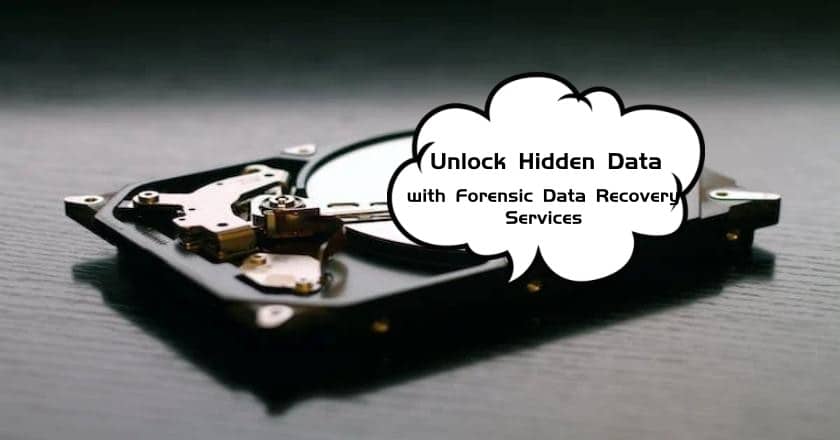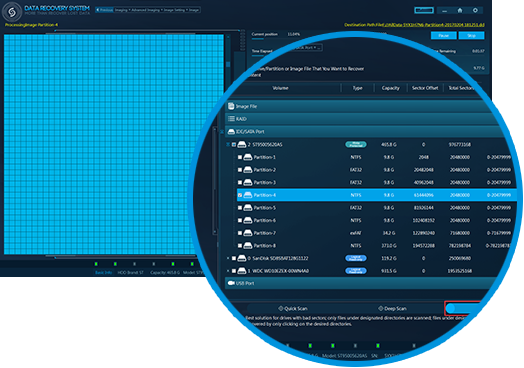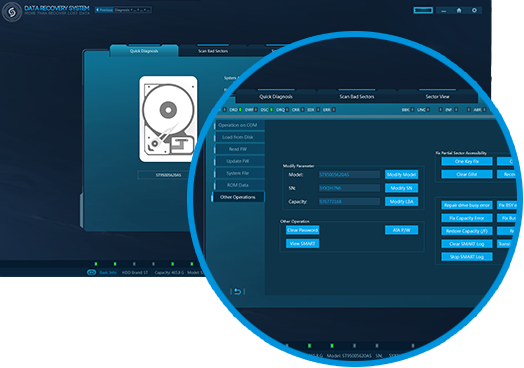Unlock Hidden Data with Forensic Data Recovery Services

-
Content
- Brief Introduction
- Process of Forensic Data Recovery
- Tools and Techniques Used in Forensic Data Recovery
- Applications of Forensic Data Recovery
- Data Recovery Services Near Me
-
Content
- Brief Introduction
- Process of Forensic Data Recovery
- Tools and Techniques Used in Forensic Data Recovery
- Applications of Forensic Data Recovery
- Data Recovery Services Near Me
Brief Introduction
The capacity to find, retrieve, and analyse hidden or lost data has become crucial in a society overflowing with digital data. This demand led to the development of the specialized field of forensic data recovery. Utilizing cutting-edge techniques to recover and rebuild data from a variety of digital devices in a way that preserves its integrity and validity is the focus of this complicated field, which is supported by organizations like SalvationDATA.
At its core, forensics data recovery is a complex procedure that concentrates on recovering inaccessible, concealed, or destroyed data from a range of digital storage mediums. This might include mobile devices, cloud storage, and hard drives and solid-state drives for computers. Not only is it important to retrieve data, but to do it in a method that ensures the data is accurate and undisturbed, allowing for its use in research or as evidence in court.
The Purpose and Importance of Forensic Data Recovery
The crucial function of forensic data recovery is to locate digital evidence, which frequently serves as the cornerstone of both judicial and corporate investigations. A properly executed forensic data recovery can either exonerate the innocent or uncover crucial evidence linking someone to criminal activity in criminal trials. In the business world, it is equally crucial for revealing fraud, comprehending data breaches, and looking into internal problems.
It is not the only goal of forensic data recovery to solve crimes or expose wrongdoings. Additionally safeguarding the integrity of our digital world and upholding justice are important. The value of the services offered by professionals in forensic data recovery, like SalvationDATA, will only grow as we continue to rely more and more on digital data in our daily lives.
Process of Forensic Data Recovery
Technical know-how and a thorough awareness of the legal criteria governing the use of digital evidence are both essential components of the careful procedure that is forensic data recovery. The identification of pertinent storage devices and media is the first crucial stage in this procedure, which also includes the gathering and preservation of data, analysis of the recovered data, and reporting of the findings.
Identification of Relevant Storage Devices and Media
The initial stage in forensic data recovery is the identification of all pertinent media and storage devices. Traditional computer systems, mobile devices for mobile data recovery, external hard drives, or even cloud-based storage could all be used in this procedure. Here, it’s important to make sure that all relevant data sources are taken into account. This thorough approach frequently produces unexpected discoveries and results in the recovery of important pieces of evidence.
Acquisition of Forensic Images to Preserve Original Data
Obtaining forensic pictures of the data is the next step after identifying the pertinent devices and media. In order to do this, a precise, bit-by-bit copy of the data from the source device or storage medium must be made. Investigators can work from copies of the original data while the original data is left undisturbed and available for verification or further study as needed thanks to this critical phase in the data recovery procedure.
Preservation of Data Integrity Throughout the Investigation
In forensic data recovery, keeping the data’s integrity throughout the inquiry is crucial. This entails making sure the data doesn’t change from its initial state, which is essential for the evidence to be accepted as evidence in court. By using appropriate handling procedures, safe storage strategies, and specialized forensic software tools, data integrity is maintained.
Analysis of Recovered Data Using Forensic Tools and Techniques
The forensic data analysis comes next when the integrity of the data has been maintained. Specialists go through the retrieved data for pertinent information using a variety of forensic tools and methods. Decrypting encrypted files and disclosing deleted or concealed data are examples of this. The data begins to divulge its secrets at this point, and the parts of the digital puzzle start to fit together.
Reporting of Findings and Preparation of Detailed Report
Reporting results is the last stage of the forensic data recovery procedure. This entails writing a thorough report that describes the techniques utilized for data recovery, the data that was retrieved, and any conclusions or revelations gleaned from the analysis. Especially in court processes where it can be utilized to exhibit the digital evidence, this report becomes a crucial record.
Overall, the process of forensic data recovery, when carried out by qualified data recovery services close to me, offers a methodical and trustworthy technique of locating digital evidence, guaranteeing that justice may be served in our increasingly digital world.
Tools and Techniques Used in Forensic Data Recovery
It takes a specialized collection of tools and procedures to find your way through the maze of digital data to find the key pieces of evidence. Experts in forensic data recovery use a variety of tools and techniques to support their thorough investigations. Software for forensic imaging, data recovery tools, file carving methods, and metadata analysis are some of the most often used tools.
Forensic Imaging Software
The technique of data recovery forensics requires forensic imaging software. With the use of this software, investigators can make an identical, bit-by-bit duplicate of the data stored on a storage device. The original data is preserved intact and undamaged by this duplication, which is frequently referred to as a forensic image. EnCase, FTK Imager, and SalvationDATA’s own suite of digital forensic tools are a few examples of this software.
Data Recovery Tools
Data that appears to be inaccessible, concealed, or erased can often be recovered using data recovery software. To recover files that might not be accessible or retrievable using conventional techniques, they go deeply into the storage system. Software like R-Studio, DRS, Recuva, and GetDataBack fall under this category. Some solutions are made especially for recovering data from mobile devices, taking into account the distinctive file systems and architectures of smartphones and tablets.
File Carving Techniques
File carving is a forensic data recovery method that enables the retrieval of files without relying on the information of the file system. This is especially helpful if files have been destroyed or the file system is damaged. Even in the absence of file directory information, file carving looks for specified file headers, footers, and structures to locate and recover data. For this purpose, equipment like Foremost and Scalpel is frequently employed.
Metadata Analysis
Information that describes other data is known as metadata. It can disclose information like the date a file was generated, who last updated it, and when. Metadata analysis can offer a plethora of knowledge and context about the material being reviewed in forensic data recovery. For instance, it can be used to create a timeline of events or locate a file’s original author. ExifTool, Metagoofil, and Cellebrite’s suite for mobile metadata extraction are a few examples of tools that are frequently used for this.
To sum up, forensic data recovery services is a sophisticated and intricate field. It makes use of cutting-edge technologies and methods to unearth and recreate data in a way that is acceptable in court. The significance of these technologies and approaches, which are easily accessible with reliable data recovery services nearby, will keep growing as our reliance on digital data increases.
Applications of Forensic Data Recovery
Applications for forensic data recovery are numerous and significant, spanning many different fields and industries. Numerous situations, such as criminal investigations, civil lawsuits, corporate investigations, and regulatory matters, demonstrate the value of its knowledge.
Criminal Investigations
Forensic data recovery is now an essential instrument in the field of criminal investigations. Finding important digital data that may establish time-frames, identify offenders, and even pinpoint locations is much easier with its support. The information included in the digital traces left by gadgets can be incredibly valuable and lead to breakthroughs in investigations that might not otherwise be addressed.
Civil Litigation
Forensic data recovery aids parties to civil litigation in gathering proof to back up their claims. This can involve anything from finding proof of contract violations in deleted emails to finding defamation on social media sites. In such cases, the outcome of a legal dispute may depend on the ability to recover and analyse data in a forensically sound manner.
Corporate Investigations
In a business setting, forensic data recovery helps with conducting internal investigations, spotting fraud, and comprehending data breaches. It is frequently used by businesses to confirm allegations of employee malfeasance, accounting irregularities, or intellectual property theft. Additionally, it is helpful in post-incident studies, such looking into a hack or data breach.
Regulatory Matters
In regulatory situations, forensic data recovery is also highly important. Organizations are required to abide by a number of privacy and data retention laws, including the General Data Protection Regulation (GDPR) and the Health Insurance Portability and Accountability Act (HIPAA). In the event of audits or regulatory scrutiny, forensic data recovery can assist businesses in verifying their compliance, locating pertinent data, and efficiently handling regulatory requirements.
Fundamentally, across a broad range of applications, forensic data recovery is a crucial role in the search for justice and the truth. Its impact will increase as our world becomes increasingly digitally intertwined and the importance of obtaining, comprehending, and analyzing digital data increases.
Data Recovery Services Near Me
It’s critical to have trustworthy services available when dealing with the complicated issues of data recovery, especially in delicate legal or investigative circumstances. SalvationDATA is one such respectable company that offers services.
In the field of data recovery and digital forensics, SalvationDATA is a major participant. Data Recovery System, a unique and integrated platform created expressly for both logical and physical data recovery from a variety of storage media, is a comprehensive suite that they have created.
DRS has a tonne of features to manage different facets of data recovery. These include disc imaging, a procedure that generates an exact clone of the device’s data for further analysis without messing with the original data, and disc diagnostics, which evaluate the health and performance of a storage device.
The package also includes file recovery and file carving features that are ideal for restoring damaged or lost files even without the use of useful file system metadata. Also, it has firmware recovery, a crucial feature for gaining access to data from devices with firmware problems.
Last but not least, DRS enables the creation of thorough reports outlining the recovery procedure and conclusions, which is essential in circumstances demanding exact documentation, such legal processes.




